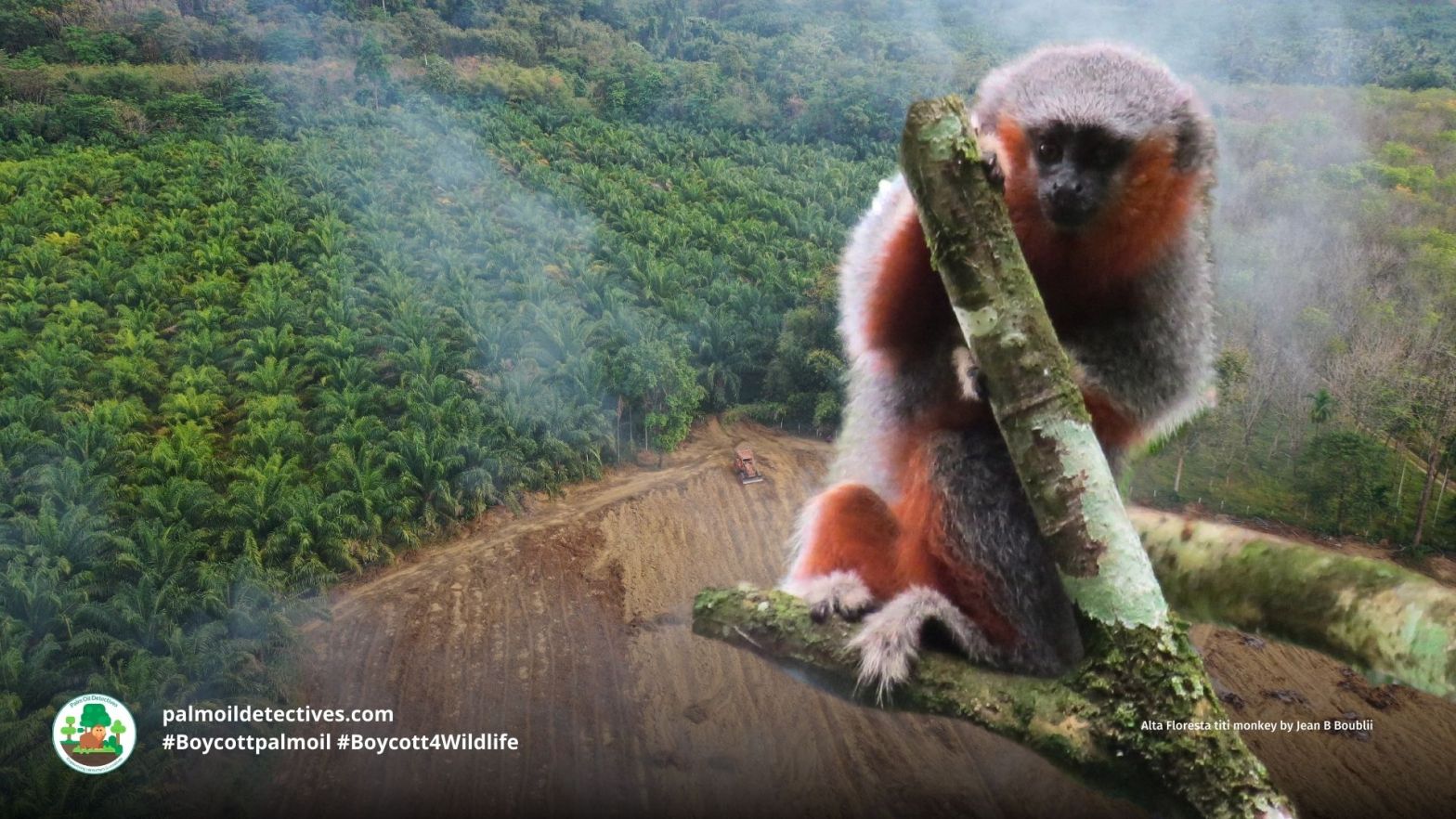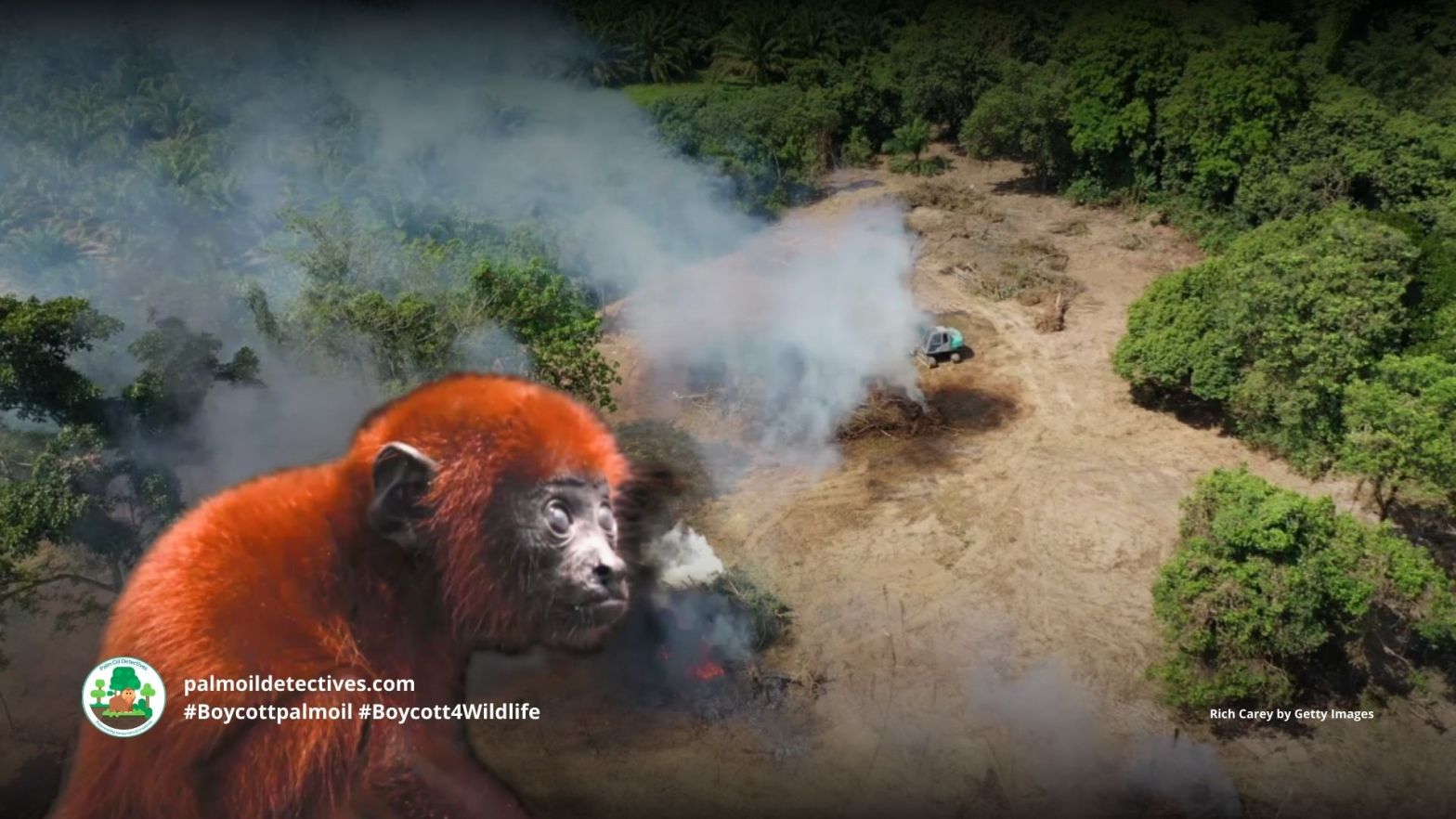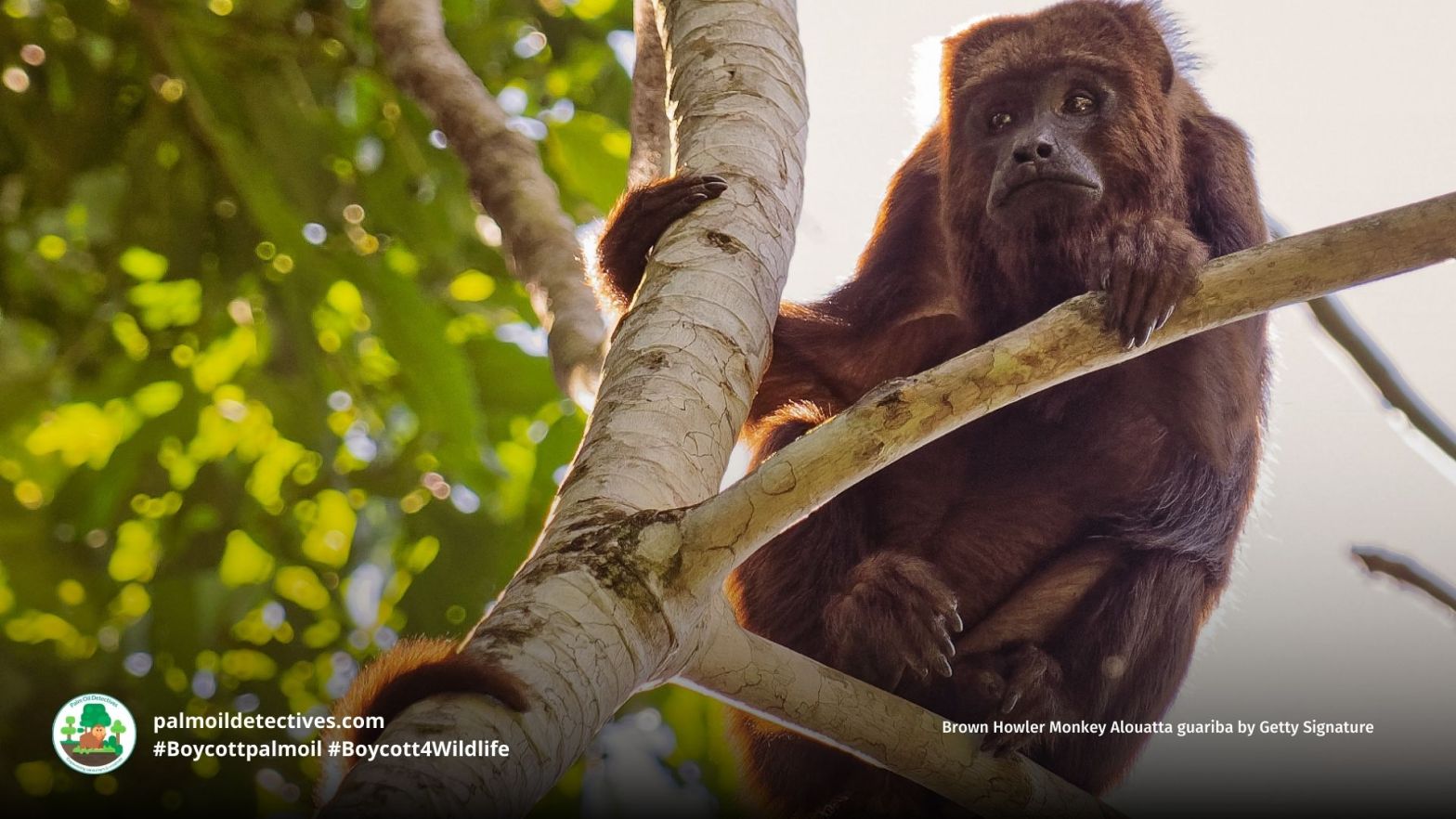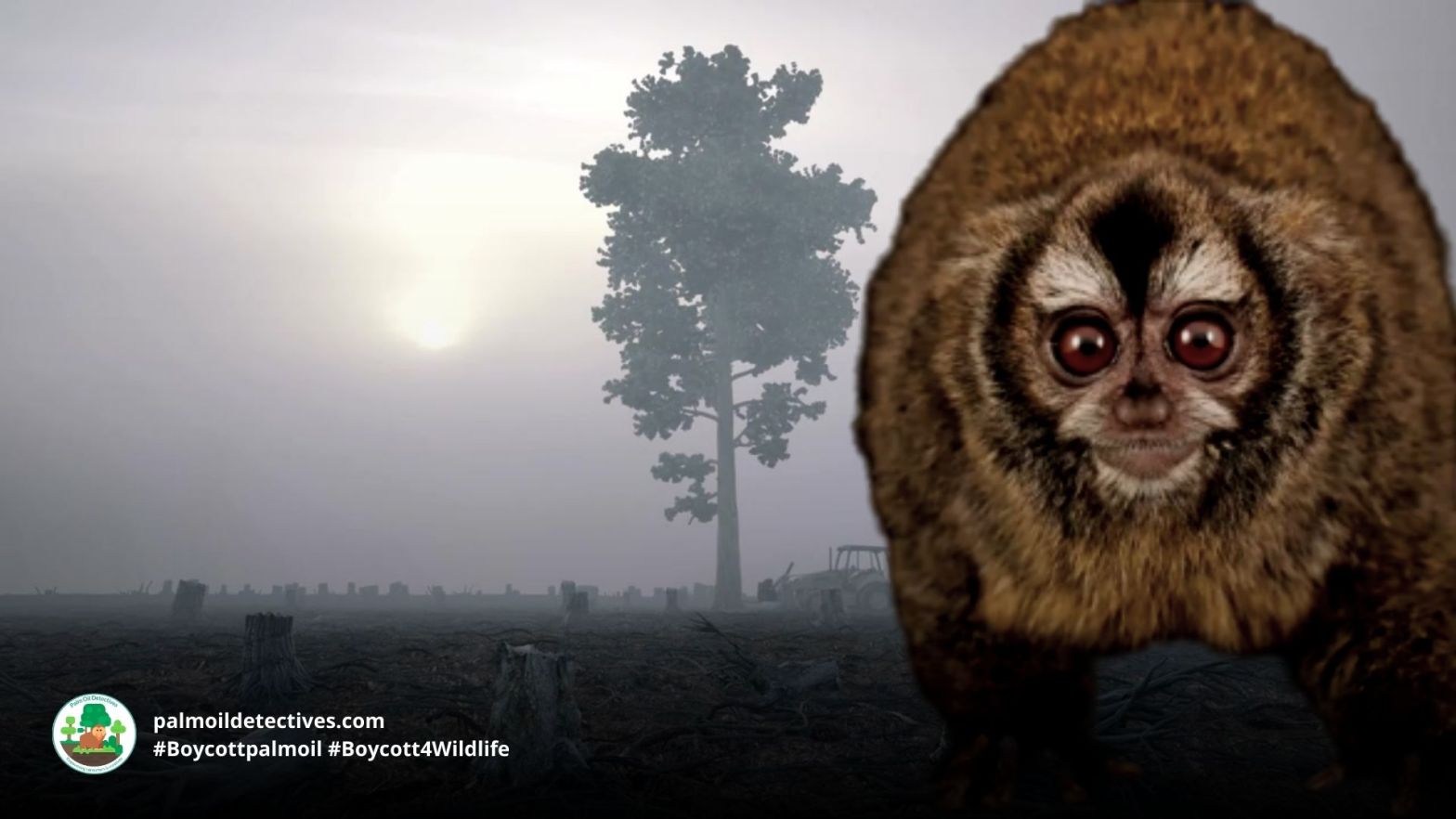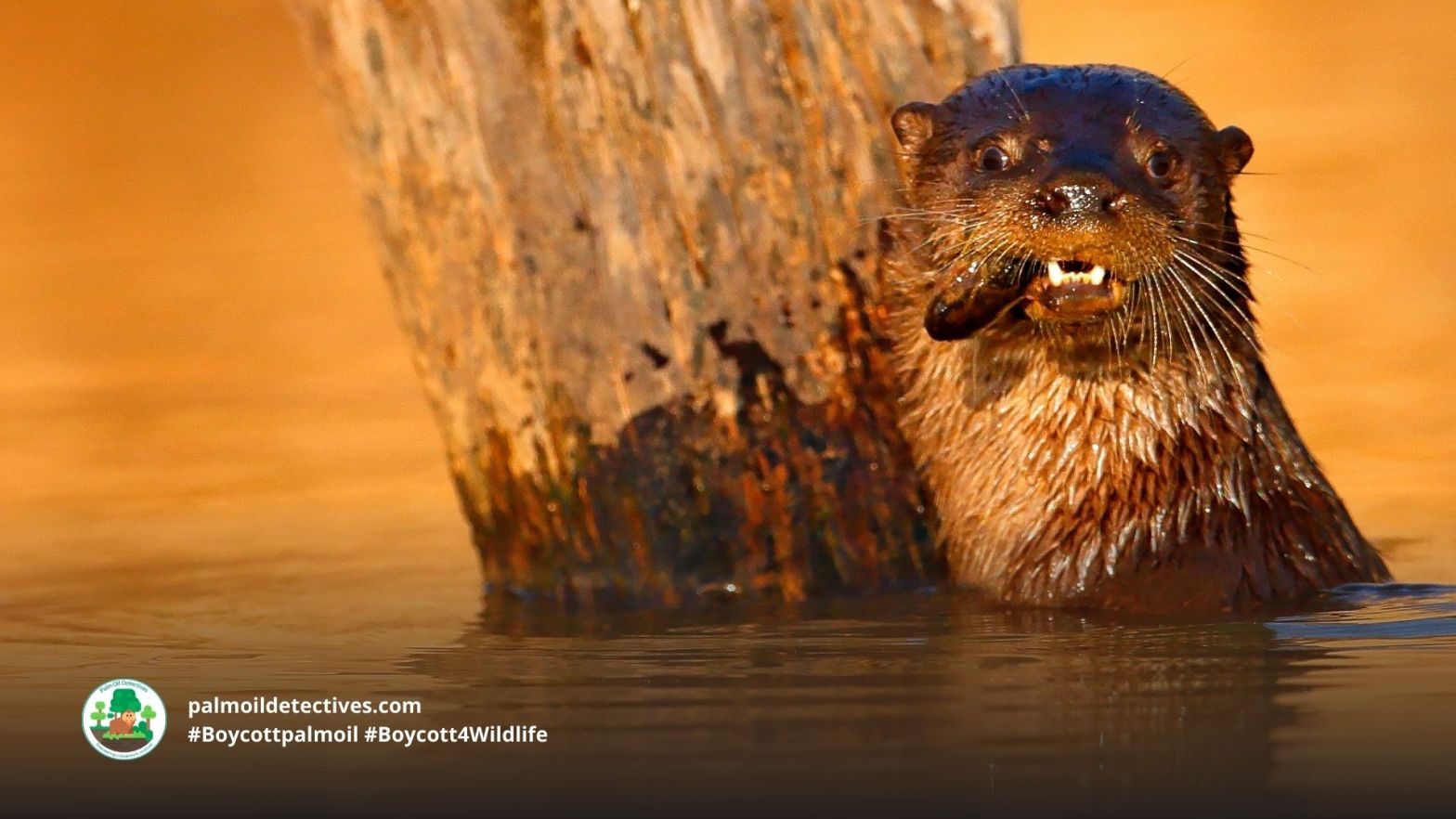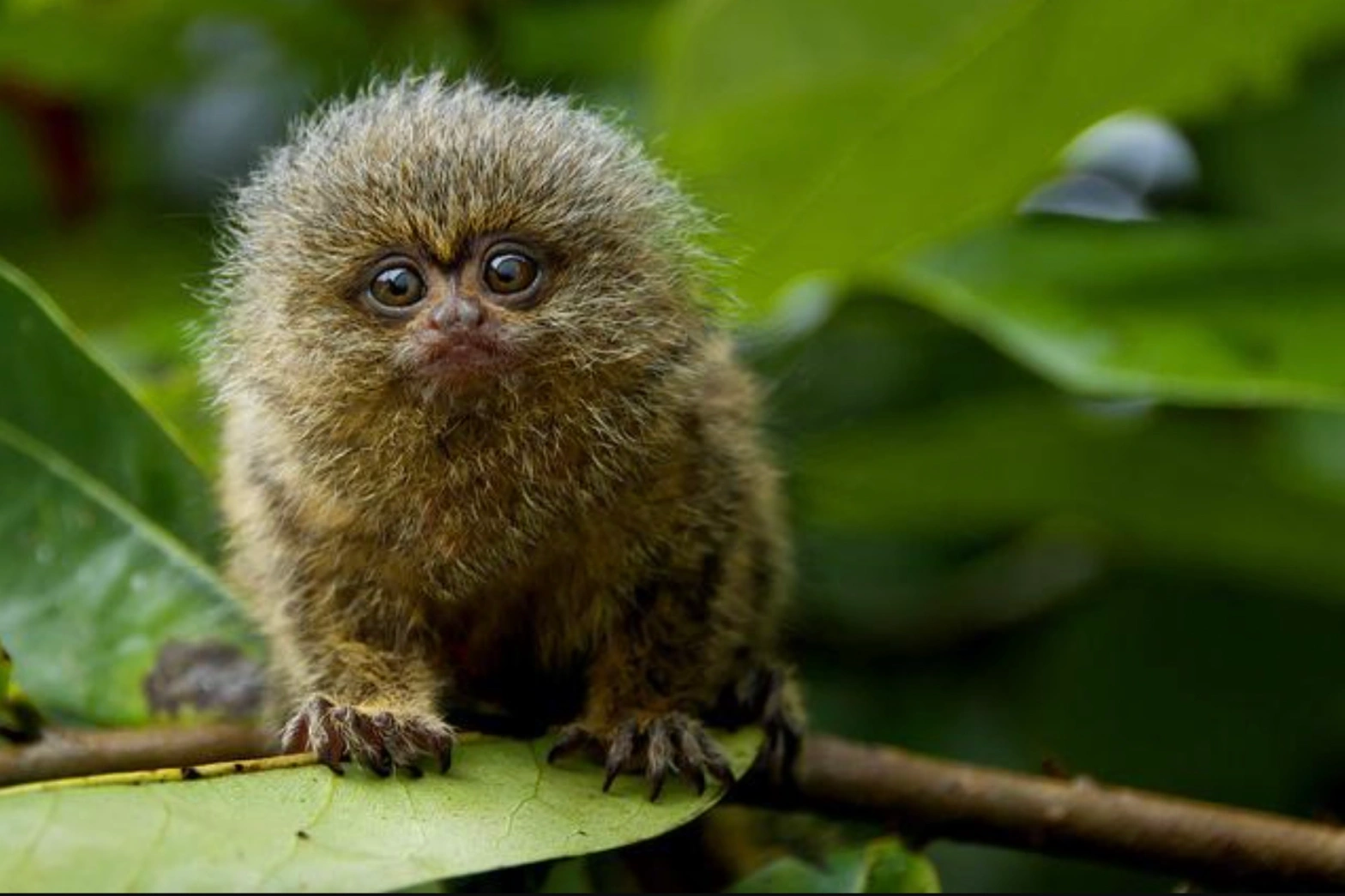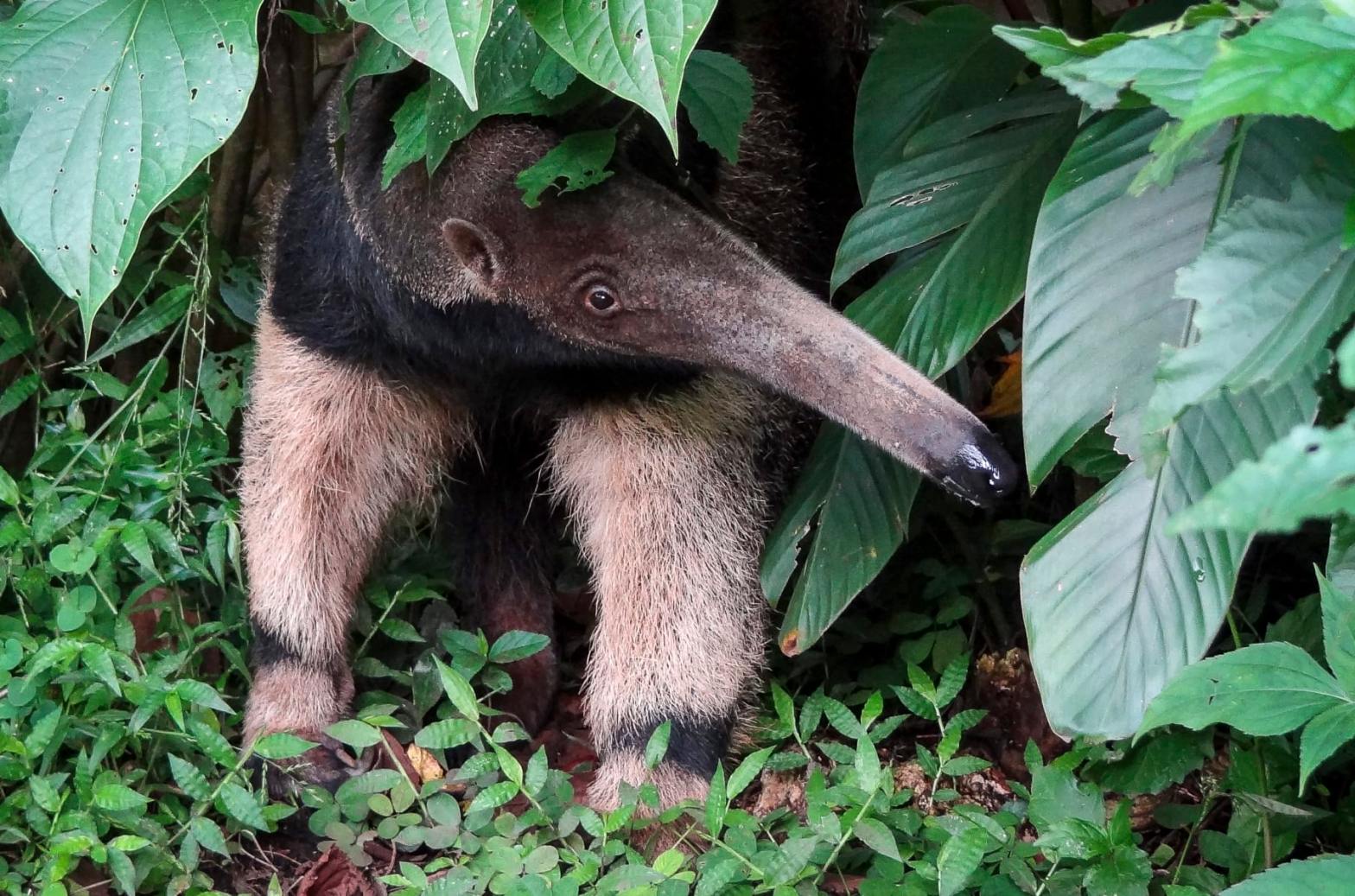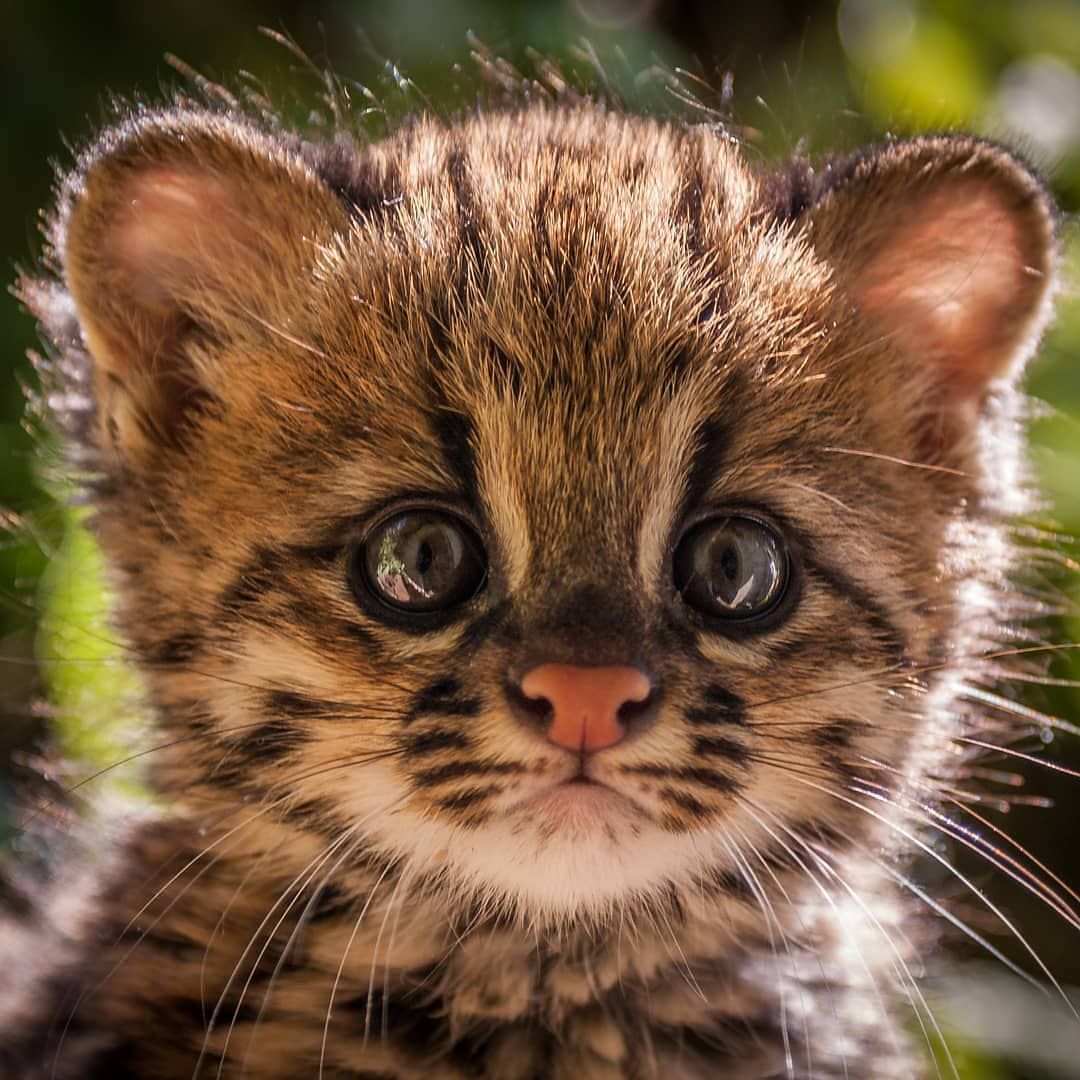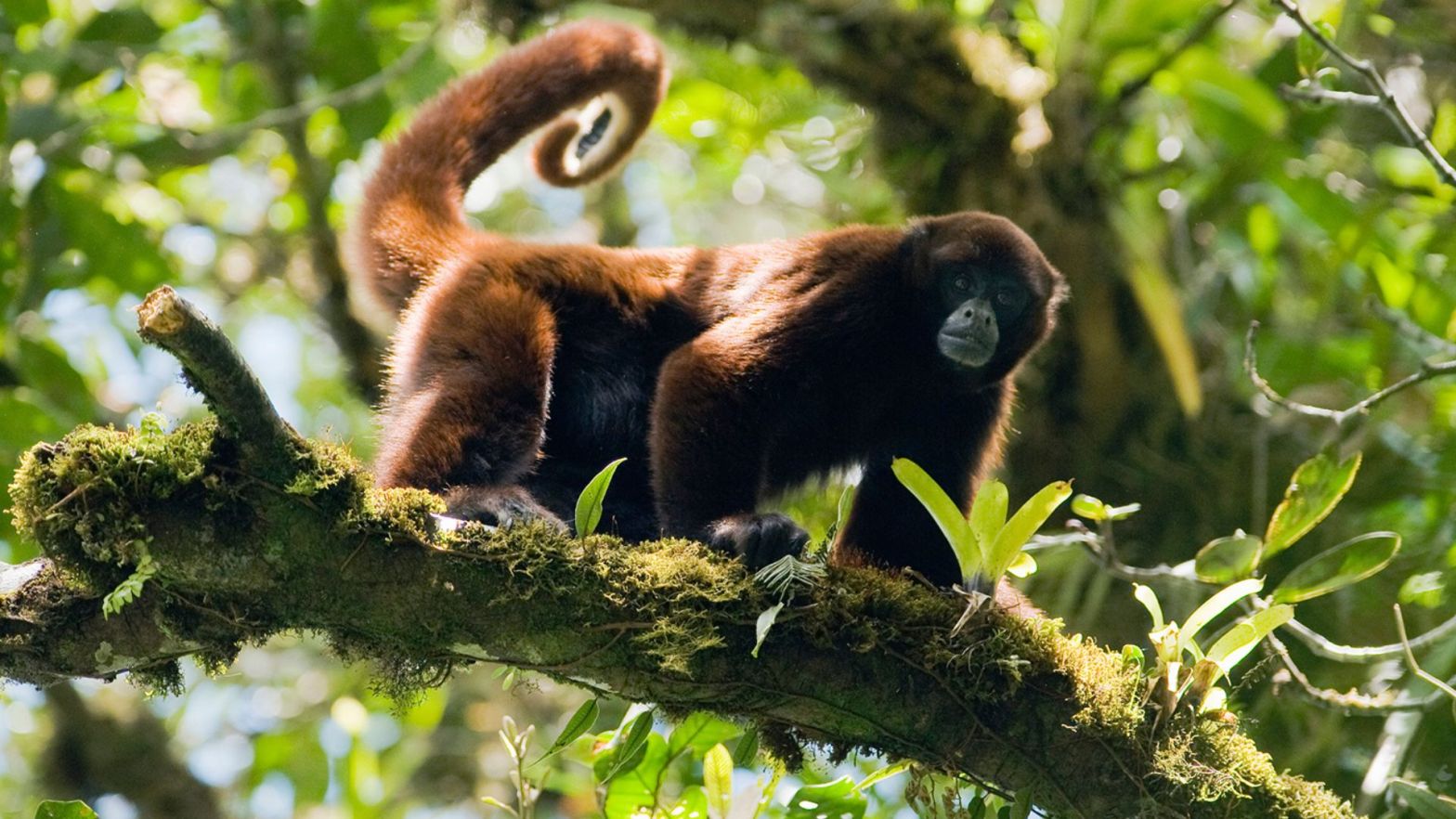The enchanting Groves Titi Monkey, also referred to as the Alta Floresta titi monkey or Mato Grosso titi monkey made a remarkable entry into the spotlight only recently in 2016 when they were classified by scientists. They belong to the Eastern Amazonian clade of the red-bellied titi monkey (P. moloch) group and are known for their vividly coloured fur and rowdy rainforest vocalisations. They face multiple anthropogenic threats including hunting gold mining, palm oil, meat and soy deforestation and hydroelectric dams. Help them to survive each time you shop, be #vegan and #Boycottpalmoil #Boycott4Wildlife
Tag Archives: South America: Species Endangered by Palm Oil Deforestation
Colombian Red Howler Monkey Alouatta seniculus
Red howlers are the largest of the howler monkey species. They have dense fur that ranges from brown to dark red, with gold or bright orange undersides – the colour can vary based on their age and habitat. Their bare, dark faces contrast with the surrounding fur. They have stubby noses, wide jaws, and thick beards. Their throats appear swollen due to an enlarged hyoid bone at the base of the tongue. Males are larger, with darker and denser beards. Their tails are exceptionally long, with the last third being hairless underneath, which helps them grip branches better. They face multiple threats including palm oil, soy and meat deforestation, the construction of hydroelectric dams, hunting and human persecution. Help them to survive each time you shop and #Boycottpalmoil #Boycott4Wildlife
Margay Leopardus wiedii
Graceful, athletic and beautiful feline of the Amazon jungle, margays are small wild cats endemic to South and Central America. Every margay has a unique spotted pattern on their coat. They depend heavily on the rainforest canopy for hunting small mammals, reptiles and amphibians and are thought to mimic the call of the pied tamarin in order to hunt for them. Deforestation for #palmoil, soy and meat along with illegal poaching are devastating to them. Help them every time you shop and be #vegan, #Boycottpalmoil #Boycott4Wildlife
Brown Howler Monkey Alouatta guariba
Despite their namesake, Brown Howlers come in a variety of colours from buff to reddish orange and brown-black. They are well known for their expressive and loud howling which can be heard from up to 2 kilometres away. Excellent seed dispersers, they are essential for maintaining a healthy rainforest. Only 12% of their forest habitat remains. Protect them every time you shop and #Boycottpalmoil #Boycott4Wildlife
Andean Night Monkey Aotus miconax
Known for their expressive big eyes, Peruvian Night Monkeys are one of the rarest and most beautiful monkeys in the world. They are critically endangered by mining, palm oil and meat deforestation. Help them every time you shop and be vegan, #Boycottpalmoil #Boycott4Wildlife!
Spiny-headed Tree Frog Triprion spinosus
A shy, arboreal species, Spiny-headed Tree Frogs are rarely seen and they live out their lives quietly in bromeliads and other tropical plants. They can be found in the subtropical forests of mountain ranges. They prefer intact forest and secondary growth forest. They have on occasion been observed living in coffee plantations.
They are found throughout the thin line of Peruvian rainforest and their range stretches across several countries: Bolivia, Ecuador, Peru, Venezuela and Colombia. Their main threats are habitat loss to mining, logging, cattle farming, palm oil and soy as well as hunting. Protect them each time you shop by boycotting meat and palm oil in the supermarket.
White-Nosed Saki Chiropotes albinasus
Curious, social and beautiful White-Nosed Sakis live in the canopies of Brazilian Amazonia. They are vulnerable from human-related threats including palm oil, soy and meat deforestation, mining and human persecution.
Their main threats are habitat loss to mining, logging, cattle farming, palm oil and soy as well as hunting. Protect them each time you shop by boycotting meat and palm oil in the supermarket.
Fight for their survival every time you shop and be #vegan #boycottpalmoil and #Boycott4Wildlife
Amazon River Dolphin Inia geoffrensis
The Amazon River dolphins, also known as the Boto Dolphins or Amazon Pink River Dolphins are playful, curious and intelligent mammals, the largest river dolphin species in the world. Known for their stunning pink coloured skin they are endangered due to human-related threats like #palmoil, #meat and #soy #deforestation, #gold #mining and #pollution. Help them survive each time you shop and use your wallet as a weapon. Be #vegan, #Boycottpalmoil and #Boycott4Wildlife
Buffy-tufted-ear Marmoset Callithrix aurita
These enchanting and charismatic tiny monkeys have a distinct “gothic” appearance. They live deep in the forests of a tiny area of Brazil. Buffy-tufted-ear Marmosets are also known as buffy tufted-ear mamosets or the white-eared marmosets. They are New World monkeys living in a geographically isolated region in the Atlantic coast that has been decimated for palm oil, soy and cattle ranching agriculture and mining. Help them every time you shop and be #vegan, #Boycottpalmoil and #Boycott4Wildlife!
Spectacled Bear Tremarctos ornatus
Spectacled bears are known as the ‘peaceful and gentle bear’. They are the only bear living in the tropics of South America. Like many other animals in tropical ecosystems they are endangered. They get their name from their eye-catching markings around their eyes, face and neck that resemble spectacles. Each bear has unique markings like a fingerprint and some bears don’t have them at all.
They are found throughout the thin line of Peruvian rainforest and their range stretches across several countries: Bolivia, Ecuador, Peru, Venezuela and Colombia. Their main threats are habitat loss to mining, logging, cattle farming, palm oil and soy as well as hunting. Protect them each time you shop by being #boycotting meat, be #vegan #boycottpalmoil #Boycott4Wildlife
Kaapori Capuchin Cebus kaapori
The Kaapori capuchin is on a knife-edge of survival – they are critically endangered. In 2017 their population had been decimated by 80% due to deforestation for agriculture including soy, cattle grazing and palm oil. They are forgotten animals with no formal protections in place. Fight for them every time you shop and be #vegan #Boycottpalmoil #Boycott4Wildlife
Giant Otter Pteronura brasiliensis
The agile and graceful tumbling Olympians of the Amazonian rivers, Giant Otters are able to swim 100 metres in less than 30 seconds. They are also known as the Lobo de Rio (the River wolf), Los Lobos del Rio (Wolves of the River) and Ariranha. They are most active in the mornings and evenings and take a siesta during the hottest parts of the day.
The most significant threats to giant otters are anthropogenic pressures of deforestation for palm oil, soy and meat, pollution from mining and climate change. They are also illegally hunted and traded for their pelts or killed in retribution by fishermen. Help them and be #vegan #Boycottpalmoil #Boycott4Wildlife
Jaguar Panthera onca
Jaguars, currently deemed Near Threatened, face a substantial habitat reduction of up to 25% in just over two decades. This decline stems from rampant deforestation for palm oil, soy, and meat, as well as illegal poaching for trophies and body parts. These magnificent creatures also suffer from conflicts arising due to livestock depredation and competition with human hunters for food. Aggravating the issue, Latin America’s widespread agricultural industries, like soy, palm oil, and cattle ranching, mainly serve foreign markets rather than local needs. Let’s step up and use our wallets as a weapons! Be #vegan #Boycottpalmoil #Boycott4Wildlife.
Santa Marta White-fronted Capuchin Cebus malitiosus
Santa Marta White-fronted Capuchin Cebus malitiosus Endangered Colombia The Santa Marta white-fronted capuchin is threatened in Colombia by habitat loss and fragmentation due to cattle ranching and oil palm agro-industries. Pet trade may also pose imminent threats to wild populations of the Santa Marta white-fronted capuchin, especially in areas where tourism is widespread. IUCN redContinue reading “Santa Marta White-fronted Capuchin Cebus malitiosus”
Pygmy Marmoset Cebuella niveiventris and Cebuella pygmaea
The petite pygmy marmoset, the world’s tiniest true monkey, boasts a mix of brownish-gold, grey, and tawny fur. These little wonders, weighing just around 100 grams, communicate uniquely using chemical, vocal, and visual cues to ensure group safety and harmony. Although these marmosets prefer river-edge forests and can adapt to secondary forests, their homes are under serious threat. Rampant deforestation, mining, and palm oil cultivation are eroding their habitats, pushing the subspecies Cebuella niveiventris towards a “Vulnerable” status. The situation is dire, with an estimated 30% reduction in their population in just 18 years. Protect these delicate creatures and their home – use your wallet as a weapon, be #vegan, #BoycottPalmOil, and #Boycott4Wildlife.🌳🐒
Giant Anteater Myrmecophaga tridactyla
Giant Anteater Myrmecophaga tridactyla Extant (resident): Argentina; Bolivia; Brazil; Colombia; Costa Rica; Ecuador; French Guiana; Guyana; Honduras; Nicaragua; Panama; Paraguay; Peru; Suriname; Venezuela Possibly Extinct: Argentina; Belize; El Salvador; Guatemala; Uruguay Vulnerable The Giant Anteater is at risk from habitat loss in parts of their range, and this is a significant threat to Central AmericanContinue reading “Giant Anteater Myrmecophaga tridactyla”
Black Bearded Saki Chiropotes satanas
Black Bearded #Sakis are #endangered large monkeys endemic to #Brazil #SouthAmerica they are #endangered by #timber #palmoil #hydroelectric dam #deforestation. Help save them every time you shop and #Boycottpalmoil #Boycott4Wildlife!
Northern Tiger Cat (Oncilla) Leopardus tigrinus
Northern Tiger Cats, or Oncillas, are sleek, large-eared wildcats often confused with margays or ocelots due to their similarities. While primarily nocturnal, they adapt their behavior according to their environment, such as hunting diurnal lizards in Caatinga. These solitary creatures, though mostly ground-dwelling, are adept climbers. They communicate through purring as kittens and a unique “gurgle” as adults. Their habitats range from the semi-arid Caatinga to the Andean cloud forests. Yet, once targeted for their fur, they now face threats from habitat loss, illegal trade, road accidents, and retaliatory killings. Let’s champion their cause and use our wallet as a weapon: be #vegan #Boycottpalmoil #Boycott4Wildlife.
Channel-billed Toucan Ramphastos vitellinus
Channel-billed Toucan Ramphastos vitellinus Vulnerable Brazil; Colombia; French Guiana; Guyana; Suriname; Trinidad and Tobago; Venezuela The primary threat to the Channel-billed Toucan is accelerating deforestation in the Amazon basin as land is cleared for cattle ranching, palm oil and soy production, facilitated by expansion of the road network (Soares-Filho et al. 2006, Bird et al.Continue reading “Channel-billed Toucan Ramphastos vitellinus”
Yellow-tailed Woolly Monkey Lagothrix flavicauda
Yellow-tailed Woolly Monkeys are social and active during daylight hours, living in groups with a dominant male, mature males and females, and young monkeys. They communicate through vocalizations like a loud, barking call. Endemic to the Peruvian Andes, they thrive in montane rainforests and cloud forests. They face an existential threat from habitat loss due to palm oil, soy and meat deforestation. Let’s unite to protect these precious creatures by boycotting palm oil, adopting a vegan lifestyle, and raising awareness for them. Together, we can protect the Peruvian Yellow-tailed Woolly Monkeys and their habitat. 🌳🐒💚 #BoycottPalmOil #Boycott4Wildlife

